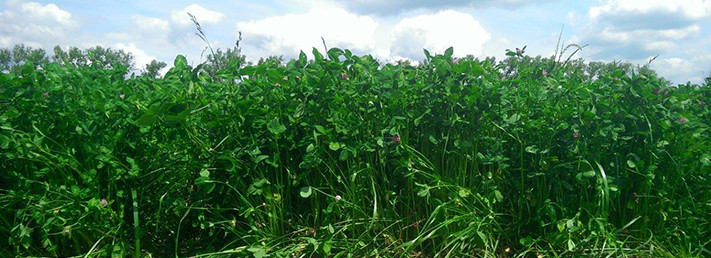Increase your milk and meat yields with red clover
Red clover is an easy species to grow and is very drought tolerant. It thrives in a wide range of soils in temperate climates, and does well all year round. Red clover tolerates low winter temperatures and, thanks to its deep taproot, is tolerant of summer droughts. These attributes make the plant a useful component of clover/grass mixtures in two- or three-year conservation leys.
09/01/2017
Sow with high-yielding grasses
For the best results, sow red clover in a mixture with high-yielding grasses. As a seed component, red clover:
- Increases field output by surviving periods of drought
- Increases production of milk and meat by raising animal intake and increasing feed conversion
- Reduces dependence on bought-in nitrogen fertiliser – red clover adds up to 250 kg N/hectare
- Reduces dependence on bought-in concentrates – red clover replaces soya or other protein sources
Click here to find ForageMax mixtures with red clover.
(Use the filter by ticking off 'Red clover' on the left side of the page).

Research proves the worth of red clover
Research case 1: red clover increases milk yield
Researchers in England (Dewhurst 2003) demonstrated a clear increase in milk yield when herds were fed a grass and red clover mixture compared to pure grass.
| Increased milk yield with red clover | ||
|---|---|---|
Silage intake: in kg of dry matter per cow per day |
Milk yield: in kg of energy corrected milk per cow per day |
|
| Perennial ryegrass | 11,4 | 26,5 |
| Perennial ryegrass + red clover | 12,9 | 31,0 |
Research case 2: red clover improves profitability
An independent pan-European research study evaluated legumes for silage production. The team concluded:
- Forage legumes can increase profitability in milk production systems.
- The most suitable species for special silage crops are red clover and, in the right conditions, alfalfa. Both give yields as high as grass receiving 200 kg N/ha.
- Where legumes are grazed as well as ensiled, grass-and-white-clover mixtures are more suitable.
- Legume silages produce higher milk yields than grass silages due to higher levels of silage intake.
Learn more
To learn more, contact your local DLF representative or product manager. They will be delighted to help.
Or read more about the value of clover and successful clover grass management.
Find a ForageMax® mixture containing red clover.
(Use the filter by ticking off 'Red clover' on the left side of the page).

